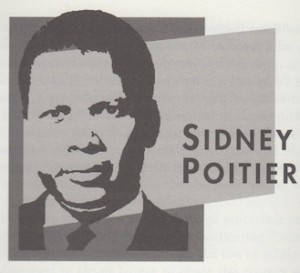Born: February 20, 1924, Miami, FL
I worked at Columbia Pictures when there wasn’t another black person to be seen.
—Sidney Poitier
Sidney Poitier grew up in the British West Indies but served in the U.S. Army during World War II as a medical assistant. Relieved of his duties and released to New York City, he took work doing light janitorial chores backstage at the American Negro Theatre. His handsome features and athletic build were attractive enough to get him small parts in several stage productions, but his thick Bahamian accent kept him from getting any speaking roles. To remove his accent, he spent nights reading books aloud and practiced enunciating the routines he heard on the radio. After his vocal lessons had finally flowered into better stage appearances, Poitier began to receive critical attention. (marandolas.com) He was making a name for himself as a black actor who exuded confidence, intelligence and self-respect. He opted for a career in movies in 1950, moved to Hollywood and landed a part in No Way Out (1950). His memorable turn in that film, combined with the recognition received for The Blackboard Jungle (1955), brought him roles that were quite unconventional.
Many of the black actors of the 1950s continued to appear in stereotypical parts. While veterans like Woody Strode were taking token parts as slaves or kitchen cooks in action adventures or westerns, Poitier was offered the thinking man’s role. His Oscar-nominated appearance in The Defiant Ones (1958) was clearly a breakthrough. The simple plot about a prison breakout was accentuated by racial issues that established Poitier as a torchbearer for a nation in the midst of the civil rights movement.
A reprise of his Broadway role in A Raisin in the Sun (1959) lead to better and better scripts, including Lilies of the Field (1963), which won him an Academy Award as Best Actor. It was the first time the award had been given to a man of color. The mainstream appeal of Poitier was evident after roles in To Sir with Love (1964) and A Patch of Blue (1965) attracted large white audiences and made him a bona fide Hollywood star. Despite his success, his roles continued to center on issues of race in In the Heat of the Night (1967), and in Guess Who’s Coming to Dinner (1967) opposite Spencer Tracy and Katharine Hepburn.
Generally acknowledged as single-handedly breaking the Hollywood color barrier, Poitier did it by making a series of films that showed a black man coping in a society dominated by whites. These films were made for first-run theaters owned and operated by whites but were also screened in many of the segregated theaters that usually only presented black films. Poitier’s true crossover appeal ushered in the first movies that blacks and whites were seeing at the same time, albeit in separate venues. He had reached a status that even the great entertainer Paul Robeson or the prolific director Oscar Micheaux never attained.
Poitier founded First Artists Production Company in 1969 and made atypical screen roles available to black actors and directors. He was also instrumental in producing black films for white audiences—films like Buck and the Preacher (1972), in which he costarred with Harry Belafonte, and Stir Crazy (1980), which starred Gene Wilder and Richard Pryor. When the black cinema of the early seventies brought new opportunities, Poitier was a natural choice for directorial duties. Uptown Saturday Night (1974), Let’s Do It Again (1975) and A Piece of the Action (1977), all with Bill Cosby, were tame versions of the genre films made by other blacks at the time, but the Blaxploitation movement that was greatly attributed to Melvin Van Peebles is still considered a direct result of Poitier’s groundbreaking sixties films.
Ironically, in the 1980s, a decade that made huge leaps in the advancement of blacks in filmmaking, Sidney Poitier was rarely seen. After a ten-year absence from acting, he resumed his career with his usual prominence and majestic power, returning to action-oriented roles in Shoot to Kill (1988) and Sneakers (1992). These films performed well at the box office, but neither focused on issues of race. Poitier’s great strides have changed the position of blacks in cinema, however, and his placement on this list will likely climb as the number of black filmmakers continues to rise.
To read all the republished articles from ‘The Film 100,’ go to Reintroducing the Film 100 here on Keyframe.





